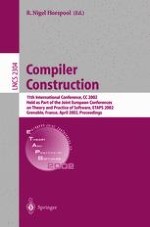2002 | OriginalPaper | Buchkapitel
CIL: Intermediate Language and Tools for Analysis and Transformation of C Programs
verfasst von : George C. Necula, Scott McPeak, Shree P. Rahul, Westley Weimer
Erschienen in: Compiler Construction
Verlag: Springer Berlin Heidelberg
Enthalten in: Professional Book Archive
Aktivieren Sie unsere intelligente Suche, um passende Fachinhalte oder Patente zu finden.
Wählen Sie Textabschnitte aus um mit Künstlicher Intelligenz passenden Patente zu finden. powered by
Markieren Sie Textabschnitte, um KI-gestützt weitere passende Inhalte zu finden. powered by
This paper describes the C Intermediate Language: a highlevel representation along with a set of tools that permit easy analysis and source-to-source transformation of C programs.Compared to C, CIL has fewer constructs. It breaks down certain complicated constructs of C into simpler ones, and thus it works at a lower level than abstract-syntax trees. But CIL is also more high-level than typical intermediate languages (e.g., three-address code) designed for compilation. As a result, what we have is a representation that makes it easy to analyze and manipulate C programs, and emit them in a form that resembles the original source. Moreover, it comes with a front-end that translates to CIL not only ANSI C programs but also those using Microsoft C or GNU C extensions.We describe the structure of CIL with a focus on how it disambiguates those features of C that we found to be most confusing for program analysis and transformation. We also describe a whole-program merger based on structural type equality, allowing a complete project to be viewed as a single compilation unit. As a representative application of CIL, we show a transformation aimed at making code immune to stack-smashing attacks. We are currently using CIL as part of a system that analyzes and instruments C programs with run-time checks to ensure type safety. CIL has served us very well in this project, and we believe it can usefully be applied in other situations as well.
